
(a)
Interpretation:
Synthesis of the given target molecule from phenylmethanol (benzyl alcohol) is to be determined.
Concept introduction:
Acid is converted to ester group by esterification reaction with the help of a strong base like
Answer to Problem 19.75P
Synthesis of the target molecule from phenylmethanol (benzyl alcohol) is

Explanation of Solution
Structure of the target molecule is
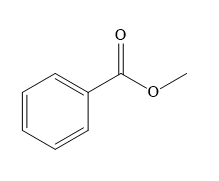
In the first step of the reaction, phenylmethanol (benzyl alcohol) is treated with oxidizing agent
In the second step of the reaction, benzoic acid undergoes esterification reaction. In this step, benzoic acid is first treated with a strong base like
The complete synthesis of the target molecule is as shown below.

By using the
(b)
Interpretation:
Synthesis of the given target molecule from phenylmethanol (benzyl alcohol) is to be determined.
Concept introduction:
For the conversion of alcohol group to Grignard reagent, alcohol (bad leaving group) is treated with
When Grignard reagent is reacted with
For the removal of water, tertiary alcohol is treated with conc.
The bromination reaction on alkene takes place in presence of
Answer to Problem 19.75P
Synthesis of the target molecule from phenylmethanol (benzyl alcohol) is
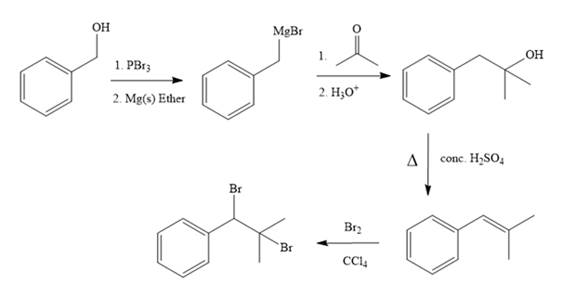
Explanation of Solution
Structure of the target molecule is
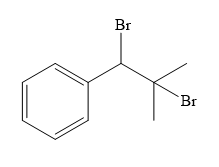
In the first step, the formation of Grignard reagent takes place. In this step, benzyl alcohol is treated with
The complete synthesis of the target molecule is as shown below.
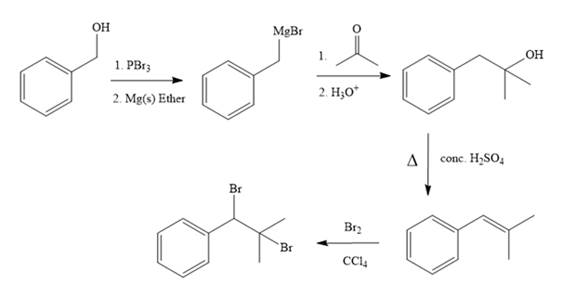
By using the functional group conversion reactions, the synthesis of the target molecule is determined.
(c)
Interpretation:
Synthesis of the given target molecule from phenylmethanol (benzyl alcohol) is to be determined.
Concept introduction:
Grignard reagent, in presence of acidic condition, is used for the conversion of aldehyde or ketone to alcohol.
For the removal of water, tertiary alcohol is treated with conc.
Reaction of alkene with diazomethane in presence of heat results in the formation of cyclopropane ring.
Answer to Problem 19.75P
Synthesis of the target molecule from phenylmethanol (benzyl alcohol) is
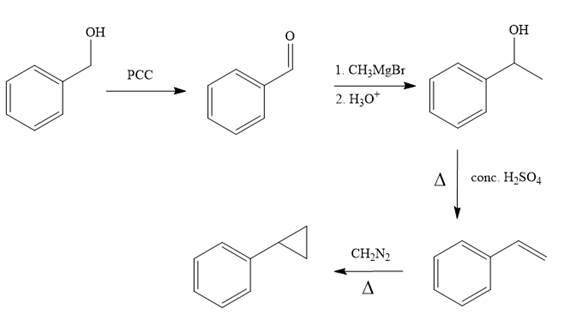
Explanation of Solution
Structure of the target molecule is
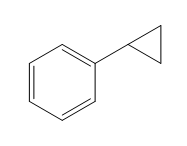
In the first step, benzyl alcohol is treated with the oxidizing agent
In the second step, benzaldehyde is treated with Grignard reagent
In the third step, the presence of conc.
In the last step, alkene is treated with diazomethane in presence of heat that results in the formation of the cyclopropane ring.
The complete synthesis of the target molecule is as shown below.
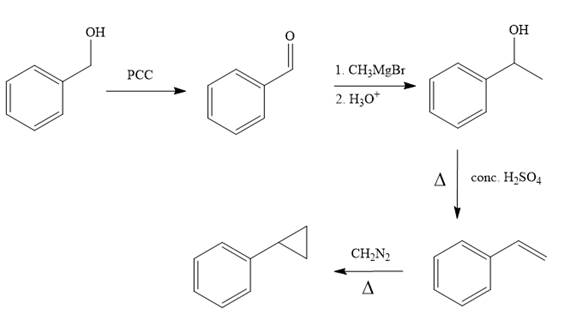
By using the functional group conversion reactions, the synthesis of the target molecule is determined.
(d)
Interpretation:
Synthesis of the given target molecule from phenylmethanol (benzyl alcohol) is to be determined.
Concept introduction:
Grignard reagent, in presence of acidic condition, is used for the conversion of aldehyde or ketone to alcohol.
Answer to Problem 19.75P
Synthesis of the target molecule from phenylmethanol (benzyl alcohol) is

Explanation of Solution
Structure of the target molecule is
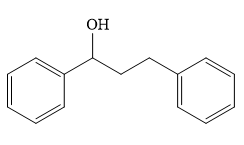
In the first step, benzyl alcohol is treated with the oxidizing agent
In the second step, benzaldehyde is treated with Grignard reagent
The complete synthesis of the target molecule is as shown below.

By using the functional group, conversion reactions synthesis of the target molecule is determined.
Want to see more full solutions like this?
Chapter 19 Solutions
EBK GET READY FOR ORGANIC CHEMISTRY
- Hi, I need your help with the drawing, please. I have attached the question along with my lab instructions. Please use the reaction from the lab only, as we are not allowed to use outside sources. Thank you!arrow_forwardHi, I need your help i dont know which one to draw please. I’ve attached the question along with my lab instructions. Please use the reaction from the lab only, as we are not allowed to use outside sources. Thank you!arrow_forward5. Write the formation reaction of the following complex compounds from the following reactants: 6. AgNO₃ + K₂CrO₂ + NH₄OH → 7. HgNO₃ + excess KI → 8. Al(NO₃)₃ + excess NaOH →arrow_forward
- Indicate whether the product formed in the reaction exhibits tautomerism. If so, draw the structure of the tautomers. CO₂C2H5 + CH3-NH-NH,arrow_forwardDraw the major product of this reaction N-(cyclohex-1-en-1-yl)-1-(pyrrolidino) reacts with CH2=CHCHO, heat, H3O+arrow_forwardDraw the starting material that would be needed to make this product through an intramolecular Dieckmann reactionarrow_forward
- Draw the major product of this reaction. Nitropropane reacts + pent-3-en-2-one reacts with NaOCH2CH3, CH3CHOHarrow_forwardIndicate whether the product formed in the reaction exhibits tautomerism. If so, draw the structure of the tautomers. OC2H5 + CoHs-NH-NH,arrow_forwardExplain how substitutions at the 5-position of barbituric acid increase the compound's lipophilicity.arrow_forward
- Explain how substitutions at the 5-position of phenobarbital increase the compound's lipophilicity.arrow_forwardName an interesting derivative of barbituric acid, describing its structure.arrow_forwardBriefly describe the synthesis mechanism of barbituric acid from the condensation of urea with a β-diketone.arrow_forward
 ChemistryChemistryISBN:9781305957404Author:Steven S. Zumdahl, Susan A. Zumdahl, Donald J. DeCostePublisher:Cengage Learning
ChemistryChemistryISBN:9781305957404Author:Steven S. Zumdahl, Susan A. Zumdahl, Donald J. DeCostePublisher:Cengage Learning ChemistryChemistryISBN:9781259911156Author:Raymond Chang Dr., Jason Overby ProfessorPublisher:McGraw-Hill Education
ChemistryChemistryISBN:9781259911156Author:Raymond Chang Dr., Jason Overby ProfessorPublisher:McGraw-Hill Education Principles of Instrumental AnalysisChemistryISBN:9781305577213Author:Douglas A. Skoog, F. James Holler, Stanley R. CrouchPublisher:Cengage Learning
Principles of Instrumental AnalysisChemistryISBN:9781305577213Author:Douglas A. Skoog, F. James Holler, Stanley R. CrouchPublisher:Cengage Learning Organic ChemistryChemistryISBN:9780078021558Author:Janice Gorzynski Smith Dr.Publisher:McGraw-Hill Education
Organic ChemistryChemistryISBN:9780078021558Author:Janice Gorzynski Smith Dr.Publisher:McGraw-Hill Education Chemistry: Principles and ReactionsChemistryISBN:9781305079373Author:William L. Masterton, Cecile N. HurleyPublisher:Cengage Learning
Chemistry: Principles and ReactionsChemistryISBN:9781305079373Author:William L. Masterton, Cecile N. HurleyPublisher:Cengage Learning Elementary Principles of Chemical Processes, Bind...ChemistryISBN:9781118431221Author:Richard M. Felder, Ronald W. Rousseau, Lisa G. BullardPublisher:WILEY
Elementary Principles of Chemical Processes, Bind...ChemistryISBN:9781118431221Author:Richard M. Felder, Ronald W. Rousseau, Lisa G. BullardPublisher:WILEY





